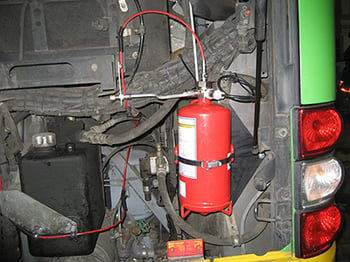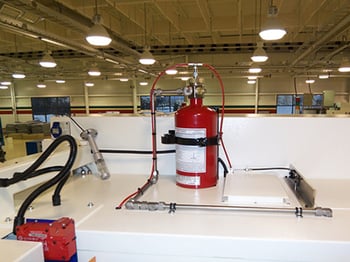How Often Should An Ansul System Be Serviced
Virtually fire suppression system components practice not have an indefinite lifetime and demand to be periodically replaced to keep the system fully functioning. NFPA guidelines state that burn suppression systems should have a semiannual inspection past a certified technician. By inspecting and replacing components when needed, yous ensure that your system will work properly to detect and suppress a fire. Here are some reasons why y'all should schedule regular inspections of your system. Components may get damaged as a event of the surroundings where they sit. Systems and components in indoor, climate-controlled locations will demand replacement less oft than those in harsher environments. Which system volition require more than frequent maintenance: the system on the bus engine or the system on the CNC car? System installation on a CNC machine If you guessed the bus engine, you are correct. The double-decker engine is subject to frequent vibration. Vibration may cause the detection tubing or discharge hoses to rub or chafe, resulting in scratches or nicks. Depending on the cylinder mount location and where the bus operates, the components tin can corrode due to salted roads, feel desperate temperature swings, and/or feel stronger vibrations from unpaved roads. This is all in add-on to the standard chemicals and debris constitute in whatever vehicles. Meanwhile, the system that protects the CNC machine is in a setting where the environmental weather are predictable and controlled. The fire suppression system's components will likely need less frequent replacement than those of the organisation protecting the motorcoach. Damaged components make fire suppression systems less effective. A faulty component can cause a system to activate when there is non a burn, leading to a simulated discharge. Conversely, a faulty component can also cause delayed activation when in that location is a burn, allowing the burn down to grow larger earlier the suppression kicks in. A non-electric fire suppression organization operates without power and actuates when the detection tubing bursts. Chaffing, cracking, or whatever other impairment that results in a hole in the tubing will crusade the organisation to discharge whether a fire is present or not. If debris is covering the detection tubing, system activation may have a filibuster because the tubing does not attain activation temperature as rapidly. This would allow the fire more fourth dimension to cause impairment to valuable equipment. If the tubing weakened by chafing or nicks, information technology has a college risk of failure. In a direct release organization, the tubing can burst at a weak indicate and not at the hottest point where the fire is. This would cause the agent to discharge in a less than an optimal area to suppresses the fire. With an indirect release system, the agent could discharge through a hole in a detection tubing or belch hose instead of through the diffuser nozzle. This leads to ineffective flooding of the environment to suppress the burn down. A well-designed system will assist to protect the burn down suppression system and its components. Using grommets or bulkheads when routing detection tubing or discharge hoses through walls volition shield it from chaffing. Minimizing loops, acme changes, and sticking to the advised turn radius for all components volition further prevent impairment. The installer should always refer to the system manual for specific design and provide you with maintenance guidelines for all components. Even in a perfectly-designed organization, components need replacement. During inspections, the certified technician will pay special attention to the detection tubing, fittings, and discharge hoses. Between scheduled inspections, if you see components looking like any of the beneath, contact your technician to supplant the parts. How oftentimes should you schedule your burn down suppression system for maintenance?
Harsh environments take a toll on components


Organisation installation on a bus engine Risks of non replacing components
False Discharge
Delayed activation
Discharge through the wrong port
Steps to protect components

How Often Should An Ansul System Be Serviced,
Source: https://www.firetrace.com/fire-protection-blog/fire-suppression-system-maintenance
Posted by: spencerbourre.blogspot.com


0 Response to "How Often Should An Ansul System Be Serviced"
Post a Comment